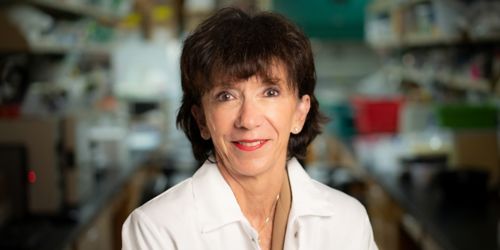St. Jude Family of Websites
Explore our cutting edge research, world-class patient care, career opportunities and more.
St. Jude Children's Research Hospital Home

- Fundraising
St. Jude Family of Websites
Explore our cutting edge research, world-class patient care, career opportunities and more.
St. Jude Children's Research Hospital Home

- Fundraising
Roussel’s early discovery shaped a career of cancer research

As a doctoral student, Roussel was part of a team that discovered three oncogenes that shaped the rest of her career.
Martine Roussel, PhD, faculty member and endowed chair in molecular oncogenesis, shares how early work and the discovery of oncogenes drove her professional science career toward these genes, which can transform a cell into a tumor cell. This is part of an ongoing series.
How were you first introduced to the science of oncogenes?
As an undergraduate student, I listened to a seminar about the oncogene Proto-oncogene tyrosine-protein kinase (Src), from Dr. Dominique Stehelin, who became my PhD mentor. I decided right then that this is what I wanted to work on. Stehelin was returning to France following his post-doctoral fellowship with Drs. Michael Bishop and Harold Varmus, who subsequently won the Nobel Prize for the discovery of oncogenes and for showing that they came from retroviruses that co-opted cellular genes to transform cells and drive cancer.
As a PhD student, I was lucky to be involved in a collaboration with Dr. Thomas Graf in Heidelberg and Michael Hayman in London. Together, we discovered three new oncogenes from avian acute leukemia viruses that we named, MAC (was renamed MYC later), ERB and MYB. This work was published in Nature in 1979.
Describe the process and the work involved in the discovery of MYC, ERB and MYB oncogenes.
My project was to purify retroviruses from litters of tissue culture and identify the oncogenes they carry. I was using technologies that Stehelin used during his post-doctoral fellowship and new ones developed in Bishop's laboratory.
We were helped greatly by the work of the virologist Thomas Graf, who isolated the viruses. Everything went relatively smoothly. I worked around the clock for four years, weekends and nights. I loved it. I was delighted to work and be part of this adventure. One setback occurred while I was purifying viruses from about 20 liters of culture medium in an ultracentrifuge at high speed. I must not have closed the lid of the rotor well enough, although I thought I did, and the centrifuge blew up. My months of work were down the drain and I had to start all over.
I also learned that collaboration was important for success and I learned failure and how to be resilient and keep going.
Were you aware of the significance of the finding then?
I frankly did not realize how important these findings were until later. In fact, I am still working on the MYC oncogenes in pediatric brain tumors. Interestingly, it did not matter what project I was pursuing, I ended up working on MYC. I have done so all my scientific career and still to this day.
Have you been able to share this work for the career development of future scientists?
Yes, this is what drives me. Frederique Zindy, PhD, and I hypothesized that MYC was inducing the tumor suppressor protein ARF, leading to its loss to drive cancer, which turned out to be right (G&D, 1989). My post-doctoral fellow, Daisuke Kawauchi, PhD, developed the first model of Group3 medulloblastoma (Cancer Cell, 2012) that enabled us to find new therapies for this aggressive and difficult to treat pediatric brain tumor (Cancer Cell, 2014), which are used in ongoing clinical trials at St Jude.
But only some of the lab members know my story – for all of them, the discovery of oncogenes is ancient history — for them, science begins when they start in my lab.






